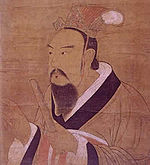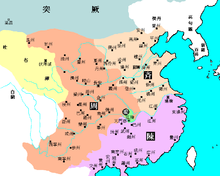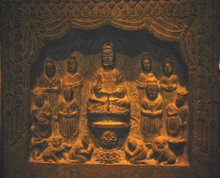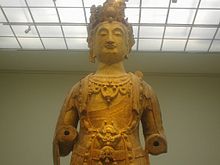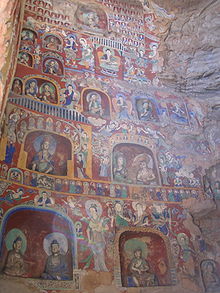- Southern and Northern Dynasties
-
- This article is about the Southern and Northern Dynasties in China. For the same-name period in other countries, see Nanboku-chō for Japan and Southern and Northern Dynasties of Vietnam.
Southern and Northern Dynasties Southern Dynasties Country Capital Number of Rulers
-Founding Emperor
-Final EmperorFounding Year
Ending YearLiu Song Jiankang 8
Liu Yu
Liu Zhun420 AD
479 ADSouthern Qi Jiankang 7
Xiao Daocheng
Xiao Baorong479 AD
502 ADLiang 1.Jiankang
2.Jiangling5
Xiao Yan
Xiao Fangzhi502 AD
557 ADChen Jiankang 5
Chen Baxian
Chen Shubao557 AD
589 ADNorthern Dynasties Country Capital Number of Rulers
Founding Emperor
Final EmperorFounding Year
Ending YearNorthern Wei 1.Shengle,
near modern
Hohhot
2.Pingcheng
3.Luoyang17
Tuoba Gui
Yuan Xiu386 AD
534 ADEastern Wei Ye 1
Yuan Shanjian
Yuan Shanjian534 AD
550 ADWestern Wei Chang'an 3
Yuan Baoju
Yuan Kuo535 AD
557 ADNorthern Qi Ye 6
Gao Yang
Gao Heng550 AD
577 ADNorthern Zhou Chang'an 5
Yuwen Jue
Yuwen Yan557 AD
581 AD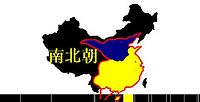
Territory at the beginning:
■ Blue represents the territory of Northern Wei,
■ Yellow represents the territory of Liu Song.The Southern and Northern Dynasties (Chinese: 南北朝; pinyin: Nánběicháo) was a period in the history of China that lasted from 420 to 589 AD. Though an age of civil war and political chaos, it was also a time of flourishing arts and culture, advancement in technology, and the spreading of Mahayana Buddhism and Daoism. The period saw large-scale migration of Han Chinese people to the lands south of the Yangtze River.
During this period the process of sinicization accelerated among the non-Chinese arrivals in the north and among the aboriginal people in the south. This process was also accompanied by the increasing popularity of Buddhism (introduced into China in the 1st century AD) in both north and south China, along with Daoism gaining influence from the outline of Buddhist scriptures (with two essential Daoist canons written during this period). Although multiple story towers such as guard towers and residential apartments existed in previous periods,[1] during this period the distinct Chinese pagoda tower (for storing Buddhist scriptures) evolved from the stupa, the latter originating from Buddhist traditions of protecting sutras in ancient India.
There were notable technological advances during this period. With the invention of the stirrup during the earlier Western Jin Dynasty, heavy cavalry became standard in combat. Advances in medicine, astronomy, mathematics, and cartography are also noted by historians. The famous Chinese mathematician and astronomer Zu Chongzhi (429–500 AD) belonged to this age, an intellectual and social product of the elite culture shaped and developed in southern China during this period of time.
Contents
Background
History of China ANCIENT 3 Sovereigns and 5 Emperors Xia Dynasty 2100–1600 BC Shang Dynasty 1600–1046 BC Zhou Dynasty 1045–256 BC Western Zhou Eastern Zhou Spring and Autumn Period Warring States Period IMPERIAL Qin Dynasty 221 BC–206 BC Han Dynasty 206 BC–220 AD Western Han Xin Dynasty Eastern Han Three Kingdoms 220–280 Wei, Shu and Wu Jin Dynasty 265–420 Western Jin 16 Kingdoms
304–439Eastern Jin Southern and Northern Dynasties
420–589Sui Dynasty 581–618 Tang Dynasty 618–907 (Second Zhou 690–705) 5 Dynasties and
10 Kingdoms
907–960Liao Dynasty
907–1125Song Dynasty
960–1279Northern Song W. Xia Southern Song Jin Yuan Dynasty 1271–1368 Ming Dynasty 1368–1644 Qing Dynasty 1644–1911 MODERN Republic of China 1912–1949 People's Republic
of China
1949–presentRepublic of
China (Taiwan)
1949–presentRelated articlesAfter the collapse of a united China under the Han dynasty in 220 AD due in large part to the Yellow Turban and Five Pecks of Rice rebellions, China eventually coalesced into the Three Kingdoms. Of these Three Kingdoms, Cao Wei was the strongest followed by Eastern Wu and Shu Han, but they were initially in a relatively stable formation. After a 249 AD coup by Sima Yi, the Sima family essentially controlled Cao Wei and soon conquered Shu Han. Following a failed coup by the ruling Cao family against the Sima family, the final Cao ruler abdicated. Sima Yan then founded the Jin Dynasty and in 280 AD conquered Eastern Wu, ending the Three Kingdoms and uniting China again.
The Jin Dynasty was severely weakened after the War of the Eight Princes from 291 to 306 AD. During the reigns of Emperor Huai of Jin and Emperor Min of Jin, the country was put into grave danger with the uprising of the northern non-Han barbarians collectively known as Wu Hu. Invading barbarian armies almost destroyed the dynasty in the Disaster of Yongjia, which was the 311 AD sack of Luoyang . Chang'an met a similar fate in the year 316 AD. However, a scion of the royal house, the Prince of Langya (Sima Rui), fled south of the Huai River to salvage what was left in order to sustain the empire. Cementing their power in the south, the Jin established modern-day Nanjing (then called Jianye and renamed Jiankang) as their new capital, renaming the dynasty as the Eastern Jin (317–420 AD) since the new capital was located southeast of Luoyang. In the north, the barbarians established numerous kingdoms, leading to the period being known as the Sixteen Kingdoms. Eventually, the Northern Wei conquered the rest of the northern states in 386 AD. Although the Chinese of the Eastern Jin (and successive southern dynasties) were well-defended from the northern barbarians by placement of naval fleets along the Yangtze River, there were still various problems faced with building and maintaining military strength. The designation of specific households for military service in the Tuntian system eventually led to a falling out in their social status, causing widespread desertion of troops on many occasions. Faced with shortage of troop numbers, Jin generals were often sent on campaigns to capture non-Chinese tribesman in the south in order to draft them into the military. The Eastern Jin Dynasty fell not because of external invasion, though, but because the general Liu Yu seized the throne from Emperor Gong of Jin, becoming Emperor Wu of Liu Song (reigned 420–422 AD), starting the Southern and Northern Dynasties period.
The Southern Dynasties
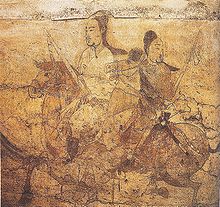 A scene of two horseback riders from a wall painting in the tomb of Lou Rui at Taiyuan, Shanxi, Northern Qi Dynasty (550–577)
A scene of two horseback riders from a wall painting in the tomb of Lou Rui at Taiyuan, Shanxi, Northern Qi Dynasty (550–577)
The Jin were supplanted by the Liu Song (420–479 AD), the Southern Qi (479–502 AD), the Liang Dynasty (502–557 AD), and then the Chen Dynasty (557–589 AD). Because all of these dynasties had their capital at Jiankang (with the exception of Liang after they moved their capital), they are sometimes grouped together with Eastern Wu and Eastern Jin as the Six Dynasties. The rulers of these short-lived dynasties were generals who seized and then held power for several decades, but were unable to securely pass power of rule onto their heirs to continue their dynasty successfully. Emperor Wu of Liang (502–549 AD), however, was the most notable ruler of his age, being a patron of the arts and of Buddhism. Under the later waning leadership of the Chen Dynasty, the southern Chinese were unable to resist the military power amassed in the north by Yang Jian, who declared himself Emperor Wen of Sui and invaded the south to reunify China.
Liu Song (420–479 AD)
Main article: Liu SongLiu Song founder Liu Yu was originally a leader of the Army of the Northern Garrison (北府军) that notably won the Battle of Fei River in 383 AD. In 404 AD, he helped suppress Huan Xuan's rebellion, leading to his dominance over the Eastern Jin court. In order to gain popularity to take the throne, Liu Yu undertook two northern expeditions against the Sixteen Kingdoms, capturing Shandong, Henan, and briefly Guanzhong by 416 AD. He gave up Guanzhong to try to take the throne. Because he believed in a prophecy saying there would be one more emperor after Emperor An of Jin, he deposed Emperor An, and soon afterwards Emperor An's replacement, Emperor Gong of Jin in 420 AD, ending the Eastern Jin dynasty. Even after crowning himself Emperor Wu of Liu Song, he remained diligently frugal. However, he did not care for education and trusted unsavory people. He felt that the nobility (世族) had too much power, so he tended to appoint the lower classes (寒族) to government positions and gave military power to imperial kinsmen. Ironically, because the imperial kinsmen stabilized their military power and wished to gain political power, Emperor Wu was afraid they would have thoughts of usurping the throne. Thus, he frequently killed his kinsmen.
After the death of Emperor Wu, his son Emperor Shao of Liu Song ruled briefly before being judged incompetent and killed by government officials led by Xu Xianzhi, replacing him with Emperor Wen of Liu Song, another son of Emperor Wu. Those government officials were soon killed by Emperor Wen. Emperor Wen's reign was a period of relative political stability because of his frugality and good government; the period was called the Yuanjia administration (元嘉之治). In 430 AD, Emperor Wen started a number of northern expeditions against Northern Wei. These were ineffective because of insufficient preparations and excessive micromanagement of his generals, decreasing weakening the dynasty. Because of his jealousy of Tan Daoji, a noted leader of the Army of the Northern Garrison, he deprived himself of a formidable general to the great delight of the Northern Wei. Thus, they were unable to capitalize when Northern Wei suffered the Wuqi Incident. Starting in 445 AD, Northern Wei, taking advantage of Liu Song's weakness, made major incursions in the lands between the Yellow and Huai River (modern Shandong, Hebei, and Henan) and devastating six provinces. Emperor Wen lamented that if Tan were still alive, he would have prevented Northern Wei advances. From then on, Liu Song was in a weakened state.
Emperor Wen was assassinated by Crown Prince Shao and the second prince Jun in 453 after planning to punish them for consorting with witchcraft. However, they were both defeated by the third prince Jun (spelled with a different character than the aforementioned Jun), who become Emperor Xiaowu of Liu Song. Emperor Xiaowu proved to be licentious and cruel, supposedly committing incest with the daughters of an uncle who had helped him gain the throne; his rivals also claimed he had incest with his mother. This led to two rebellions by the imperial clan, one of which saw him slaughter the inhabitants of Guangling. The following ballad gives an idea of those times:
- 遥望建康城, Looking toward Jiankang city
- 小江逆流萦, the little river flows against the current
- 前见子杀父, in front, one sees sons killing fathers
- 后见弟杀兄。 and behind, one sees younger brothers killing older brothers a[›]
Emperor Xiaowu died naturally in 464 AD and was succeeded by his son, who became Emperor Qianfei of Liu Song. Emperor Qianfei proved to be similar to his father, engaging in both kin slaughter and incest. In a scandalous move, because his sister complained about how it was unfair that men were allowed 10,000 concubines, he gave her 30 handsome young men as lovers. His uncle Liu Yu, the Prince of Xiangdong, whom he called the "Prince of Pigs" for his obesity, eventually assassinated him and became Emperor Ming of Liu Song. Emperor Ming began his reign by killing all the descendants of Emperor Xiaowu, and his suspicious nature resulted in the loss of the provinces north of the Huai River, which were only briefly regained in the other Southern Dynasties. Emperor Ming's young son became Emperor Houfei of Liu Song. The political situation was volatile. The general Xiao Daocheng slowly gained power and eventually deposed Emperor Houfei in favor of his brother who became Emperor Shun of Liu Song. After defeating his rival general Shen Youzhi, Xiao forced Emperor Shun to yield to throne and crowned himself as Emperor Gao of Southern Qi, ending the Liu Song dynasty.
Southern Qi (479–502 AD)
Main article: Southern QiThough distantly related, the Southern Qi and the following Liang dynasty were members of the Xiao (萧) family from Lanling (兰陵, in modern Cangshan County, Shandong). Because Emperor Gao had a low social standing, he earned the disdain of nobility. His style of governance was similar to the early style of the Liu Song dynasty and was very economical. He died in the fourth year of his reign and his, who was only 13 years younger than him, succeeded him as Emperor Wu of Southern Qi. Emperor Wu made peace with the Northern Wei, content to protect his borders. This period of peace was known as Yongming Administration (永明之治). He also used government secretaries (典签官) appointed with provincial governors and members of the imperial clan to monitor them.
The short reigns of Emperor Wu's grandsons, Xiao Zhaoye and Xiao Zhaowen (his first son predeceased him), were dominated by Xiao Luan, Emperor's Wu's first cousin. He killed them in turn and crowned himself as Emperor Ming of Southern Qi. Using the government secretaries (典签官), he slaughtered all the descendants of Emperors Gao and Wu. Emperor Ming soon became very ill and started following Daoism, changing his whole wardrobe to red. He also passed an edict making officials try to find silver fish (银鱼). He died in 498 AD and was succeeded by his son Xiao Baojuan, whose killed high officials and governors at his whim, sparking many revolts. The final revolt in 501 AD started after Xiao Baojun killed his prime minister Xiao Yi, leading his brother Xiao Yan to revolt under the banner of Xiao Baojun's brother who was declared Emperor He of Southern Qi. Xiao Baojun was killed by one of his general during the siege of his capital at Jiankang, and after a short puppet reign by Emperor He, Xiao Yan overthrew the Southern Qi and established the Liang dynasty.
Liang (502–557 AD)
Main article: Liang DynastyEmperor Wu was economical, worked hard at governing, and cared for the common people. His early reign was known as Tianjian Administration (天监之治). The Liang dynasty's military strength gradually surpassed the strength the Northern Wei, who suffered internal strife due to their policy of sinicization. In 503 AD, Norhtnern Wei invaded, but were defeated at Zhongli (modern Bengbu). He supported Northern Expeditions, but did not aggressively take advantage of his victory in 516 AD at Shouyang because of heavy casualties. Given the excessive kin-slaughter in the Liu Song and Southern Qi dynasties, Emperor Wu was very lenient to imperial clansmen, not even investigating them when they committed crimes. Because Emperor Wu was very learned, supported scholars, and encouraged the flourishing education system, the Liang dynasty reached a cultural peak. An avid poet, Emperor Wu was fond of gathering many literary talents at court, and even held poetry competitions with prizes of gold or silk for those considered the best.
However, in his later years, sycophants surrounded him and because of his belief in Buddhism, he dedicated his life (舍身) and tried to become a monk three times to Buddhism, but each time was persuaded to return by extravagant court donations to Buddhism. Furthermore, since Buddhists and Daoists were exempt from taxation, nearly half of the population fraudulently named themselves as such, badly damaging state finances. Imperial clansmen and officials were also greedy and wasteful.
Because Emperor Wu was willing to accept defected generals from Northern Wei, when Northern Wei suffered major revolts in their northern garrison towns, he sent his general Chen Qingzhi to support the pretender Yuan Hao. Despite the fact that Chen was only given 7,000 troops, Chen still managed to defeat army after army and even captured Luoyang, the capital of Northern Wei. Ultimately, Chen was not supplied enough and was defeated by troops ten times his size. After the splitting of Northern Wei into Eastern and Western Wei, Emperor Wu granted asylum to rebel Eastern Wei commander Hou Jing, sending him on Northern Expeditions against Eastern Wei. After some initial successes, Liang forces were decisively defeated. Rumors abounded that Emperor Wu intended to give Hou as a peace offering. Despite Emperor Wu's assurances, Hou decided to rebel in the name of Xiao Dong, the grandson of the former crown prince Xiao Tong who died in 531 AD and was removed from crown prince because of conflicts with his father. Hou surprised Emperor Liang by besieging the Liang capital at Jiankang. Attempts by Liang forces to break the siege failed, and Emperor Wu was forced to negotiate a ceasefire and peace. However, because Hou thought that since peace was not sustainable, he broke the ceasefire and captured the palace. The slaughter of the nearby populace occurred. Emperor Wu was starved to death and after the short puppet reigns of crown prince Xiao Gang and Xiao Dong, Hou seized power in his own hands and established the Han dynasty.
In spite of conquering Jiankang, Hou essentially only controlled the nearby areas. The rest of the Liang dynasty lands were under the control of members of the imperial clan. Their squabbling amongst themselves weakened their efforts to defeat Hou. In the end, Xiao Yi with the aid of his generals Wang Sengbian and Chen Baxian defeated Hou, crowning himself Emperor Yuan of Liang. His brother Xiao Ji based in Sichuan was still a major threat. Emperor Yuan asked for assistance from Western Wei to defeat Xiao Ji, but after subduing Xiao Ji, they kept Sichuan. Due to a diplomatic faux pas, he incited the anger of Yuwen Tai, the leading general of Western Wei, which resulted in him being deposed and his death. Western Wei set up the puppet state of Western Liang with capital at Jiangling. Northern Qi also had designs on the Liang throne, and sent an expedition under the banner of the a cousin of Emperor Yuan. Chen Baxian and Wang Sengbian set up the last surviving son of Emperor Yuan, Xiao Fangzhi, as Liang ruler, but he was not given the imperial title. After some defeats to the forces of Northern Qi, Wang Sengbian allowed their pretender, Xiao Yuanming to establish himself as Emperor Min of Liang. However, Chen Baxian was displeased with the arrangements, and in a surprise move killed Wang and deposed Emperor Min in favor of Xiao Fangzhi who became Emperor Jing of Liang. After a short reign, Chen deposed Emperor Jing and took power himself as Emperor Wu of Chen in 557 AD.
Chen (557–589 AD)
Main article: Chen DynastyEmperor Wu of Chen came from the region of Wu (a region near modern-day Shanghai). At that time, due to the Hou Jing rebllion, the Qiao and Wu clans were greatly weakened, and many places set up independent regimes. Because Emperor Wu had could not pacify all the independent regimes, he adopted conciliatory measures. After the sudden death of Emperor Wu, his nephew Chen Qian took power as Emperor Wen of Chen. After the fall of Liang, the general Wang Lin had established an independent kingdom based in modern day Hunan and Hubei provinces and was now starting to cause trouble. Wang Lin allied with Northern Wei and Northern Qi to take take conquer the Chen capital at Jiankang. Emperor Wen first defeated the combined forces of Northern Qi and Wang Lin before preventing the forces of Northern Wei from entering the South at Yueyang. Furthermore, through Emperor Wen's extensive efforts at good governance, the economic situation of the South was greatly improved, restoring his kingdom's national strength.
Following the death of Emperor Wen, his son, the weak-willed Chen Bozong, took power and became Emperor Fei of Chen. His uncle, Chen Xu, after essentially controlling the country through his short reign, eventually deposed him and took power as Emperor Xuan of Chen. At that time, the Northern Wei intended to conquer Northern Qi and thus invited the Chen dynasty to help. Emperor Xuan agreed to help because he wanted to recover the lost territories south of the Huai River. In 573 AD, he sent general Wu Mingche to assist the effort; in two years, he managed to recover he lost territories south of the Huai River. At the time, Northern Qi was in a precarious situation with little military strength and Emperor Xuan could have taken advantage of the opportunity to entirely defeat Northern Qi. However, he only wanted to protect his territories south of the Huai River. Northern Wei instead took advantage of Northern Qi's weakness and following their defeat of Northern Qi, in 577 AD, they sent troops to the territories south of the Huai River, where they decisively defeated the Chen dynasty forces. The Chen dynasty was in imminent danger.
In a stroke of fortune, Northern Wei's Emperor Wu suddenly died and his general Yang Jian attempted to take the throne. This stopped the southern advance of the Northern Troops. The respite was short though as after Yang Jian defeated his rival General Weichi Jiong, he usurped the throne from Emperor Jing of Northern Zhou and established the Sui Dynasty, crowning himself Emperor Wen of Sui. He proceeded to invade the south to reunify China. Emperor Xuan had just died and his son incompetent son Chen Shubao (Houzhu of Chen) took power. He was licentious and wasteful, resulting in chaos and corruption in the government; many of those government officials heavily exploited the people, causing great suffering. In planning tactics defeat the Chen dynasty, Emperor Wen of Sui took the suggestion of his general Gao Jiong and waited until the South were harvesting their crops to entirely burn the farmland, crippling the strength of the Chen dynasty. In 588 AD, Emperor Wen of Sui sent his son Yang Guang (who would become Emperor Yang of Sui) to finally vanquish the Chen dynasty. Chen Shubao relied on the natural barrier of the Yangtze River and continued as always with his festive and licentious activities. The next year, Sui forces captured the Chen capital of Jiankang. Chen Shubao and his favorite concubine Zhang Lihua attempted to hide in a well, but eventually were captured by Sui forces, thus ending the Chen dynasty.
The Northern Dynasties
In the first half of the Northern Wei Dynasty (386–534 AD), the Xianbei steppe tribesmen who dominated northern China kept a policy of strict social distinction between them and their Chinese subjects. Chinese were drafted into the bureaucracy, employed as officials to collect taxes, etc. However, the Chinese were kept out of many higher positions of power. They also represented the minority of the populace where centers of power were located, such as the first Northern Wei capital at Pingcheng in modern-day northern Shanxi province.
Widespread social and cultural transformation in northern China came with Emperor Xiaowen of Northern Wei (reigned 471–499 AD), whose father was a Xianbei, but whose mother was Chinese. Although of the Tuoba Clan from the Xianbei tribe, Emperor Xiaowen asserted his dual Xianbei-Chinese identity, renaming his own clan after the Chinese Yuan (元 meaning "Elemental"). In the year 493 Emperor Xiaowen instituted a new sinification program that had the Xianbei elites conform to many Chinese standards. These social reforms included donning Chinese clothing (banning Xianbei clothing at court), learning the Chinese language (if under the age of thirty), applied one-character Chinese surnames to Xianbei families, and encouraged the clans of high-ranking Xianbei and Chinese families to intermarry. Emperor Xiaowen also moved the capital city from Pingcheng to one of China's old imperial sites, Luoyang, which had been the capital during the earlier Eastern Han and Western Jin dynasties. The new capital at Luoyang was revived and transformed, with roughly 150,000 Xianbei and other northern warriors moved from north to south to fill new ranks for the capital by the year 495. Within a couple decades, the population rose to about half a million residents, and was famed for being home to over a thousand Buddhist temples. Defectors from the south, such as Wang Su of the prestigious Langye Wang family, were largely accommodated and felt at home with the establishment of their own Wu quarter in Luoyang (this quarter of the city home to over three thousand families). They were even served tea (by this time gaining popularity in southern China) at court instead of yogurt drinks commonly found in the north.
In the year 523, Prince Dongyang of the Northern Wei was sent to Dunhuang to serve as its governor for a term of fifteen years. With the religious force of Buddhism gaining mainstream acceptance in Chinese society, Prince Dongyang and local wealthy families set out to establish a monumental project in honor of Buddhism, carving and decorating Cave 285 of the Mogao Caves with beautiful statues and murals. This promotion of the arts would continue on for centuries at Dunhuang, and is now one of China's greatest tourist attractions.
In that same year of 523 a revolt of several military garrisons was caused by a food shortage far north of Luoyang. After this was suppressed, the government had 200,000 surrendered garrison rebels deployed to Hebei, which proved later to be a mistake when a former garrison officer organized another rebellion in the years 526–527. The Wei court was betrayed by one of their own generals, who had the empress dowager and the young emperor thrown into the Yellow River, while establishing his own puppet ruler to maintain authority. As conflict swelled in the north between successive leaders, Gao Huan took control of the east and Luoyang (holding Emperor Xiaojing of Eastern Wei as a puppet ruler) by 534, while his rival Yuwen Tai took control of the west and the traditional Chinese capital of Chang'an by 535. Eventually, Gao Huan's son Gao Yang forced the Eastern Wei emperor to abdicate in favor of his claim to the throne, establishing the Northern Qi Dynasty (551–577 AD). Afterwards, Yuwen Tai's son Yuwen Jue seized the throne of power from Emperor Gong of Western Wei, establishing the Northern Zhou Dynasty (557–580 AD). The Northern Zhou Dynasty was able to defeat and conquer Northern Qi in 577, reunifying the north. However, this success was short-lived, as the Northern Zhou was overthrown in 581 by Yang Jian, who became Emperor Wen of Sui. With greater military power and morale, along with convincing propaganda that the Chen Dynasty ruler Chen Shubao was a decadent ruler who had lost the Mandate of Heaven, the Sui Dynasty was able to effectively conquer the south. After this conquest, the whole of China entered a new golden age of reunification under the centralization of the short-lived Sui Dynasty and succeeding Tang Dynasty (618–907 AD).
Northern Wei (386–534 AD)
Main article: Northern WeiEastern Wei (534–550 AD)
Main article: Eastern WeiWestern Wei (535–557 AD)
Main article: Western WeiNorthern Qi (550–577 AD)
Main article: Northern QiNorthern Zhou (557–581 AD)
Main article: Northern ZhouCulture
Philosophy
Confucianism's unchallenged domination of Chinese culture and thought was greatly weakened during the Jin Dynasty, which lead to a wide diversification of political thought and philosophy by the time of the Southern and Northern Dynasties. This era produced a myriad of writers that advocated practical systems of governance and administration, such as Cao Cao and Zhuge Liang in the Three Kingdoms Period, Wang Dao and Bao Jingyan of the Eastern Jin, as well as Fan Zhen, Xing Shao (Chinese: 邢邵), and Fan Xun (Chinese: 樊逊) of the Southern and Northern period. Much of the philosophy of the period is despondent and dispirited, and a number of scholars and poets became reclusive mountain hermits living apart from society.[2] Of these various trends, the most influential was Neo-Daoism (Chinese: 玄学; pinyin: Xuánxué). Neo-Daoism was highly influential during the Southern Dynasty, to the point that Emperor Wen of Liu Song established a Neo-Daoist Academy and promoted it, along with Confucianism, literature, and history, as the four great subjects of study. A phenomenon known as "empty chat" (Chinese: 清谈; pinyin: Qīng tán) became common, where educated men would meet and talk about philosophy all day without paying any attention to "mundane" things such as their profession or family. The phenomenon gradually waned during the Sui Dynasty, though it did not fully disappear until the Tang Dynasty.[3]
Literature
Literature was particularly vibrant during the Southern Dynasty and tended to be flowery and frilly, while Northern Dynasty literature was rougher and more straightforward. Notable writers include Yu Xin, Xing Fang, Wei Shou, and Wen Zisheng of the Northern Dynasty. In the Southern Dynasty, a type of essay known as pian wen (Chinese: 骈文), which used metered rhyme, flowery language, and classical allusions, became popular. Writings often spoke of removing oneself from everyday material existence and jettisoning cares and anxiety.
Poets of the Southern and Northern Dynasties focused on imitating older classical poets of Ancient China, formalizing the rhyme patterns and meters that governed poem composition. However, scholars realized that ancient songs and poems, like those of the Shijing, in many instances no longer rhymed due to sound shifts over the previous centuries. The introduction of Buddhism to China, which began in the late Han Dynasty and continued through the Tang Dynasty, introduced Chinese scholars to Sanskrit and its highly organized phonological system. For the first known time, Chinese scholars began attempting to analyze and categorize the syllables and tones of their language and dialects. During this period, scholar Zhou Yi wrote the first known description of the four tones of early Middle Chinese.
Other
The southern dynasties of China were rich in cultural achievement, with the flourishing of Buddhism and Daoism; especially the latter as two new canons of scriptual writings were created for the Supreme Purity sect and its rival the Numinous Treasure Sect. The southern Chinese were influenced greatly by the writings of Buddhist monks such as Huiyuan, who applied familiar Daoist terms to describe Buddhism for other Chinese. The Chinese were in contact and influenced by cultures of India and trading partners farther south, such as the kingdoms of Funan and Champa (located in modern-day Cambodia and Vietnam). The Chinese arts of poetry, calligraphy, painting, and playing of music found greater precedent during this age, as their sophistication and complexity reached new heights. The earlier Cao Zhi, son of Cao Cao, is regarded as one of the greatest poets of his day. His style and deep emotional expression in writing influenced later poets of this new age, such as Tao Qian (365–427 AD) or Tao Yuanming. Even during his lifetime, the written calligraphy of the "Sage of Calligraphy", Wang Xizhi (307–365 AD), was prized by many and considered a true form of personal expression like other arts. In regards to painting, this art became highly prized with artists such as Gu Kaizhi (344–406 AD), who largely established the tradition of landscape art in classical Chinese painting (to learn more, refer to the "Far East" section of the article for Painting). Institutions of learning in the south were also renowned, including the Zongmingguan (Imperial Nanjing University), where the famed Zu Chongzhi (mentioned above) had studied. Zu Chongzhi devised the new Daming Calendar in 465 AD, calcuated one year as 365.24281481 days (which is very close to 365.24219878 days as we know today), and calculated the number of overlaps between sun and moon as 27.21223 (which is very close to 27.21222 as we know today). Using this number he successfully predicted 4 eclipses during a period of 23 years (from 436–459 AD).
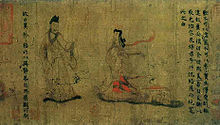 Part of the scroll for Admonitions of the Instructress to the Palace Ladies, a Tang Dynasty duplication of the original by Gu Kaizhi.
Part of the scroll for Admonitions of the Instructress to the Palace Ladies, a Tang Dynasty duplication of the original by Gu Kaizhi.
Demographic Changes
It was during the Southern and Northern Dynasties period that southern China (below the Yangtze River) was greatly developed from its previous state of early Chinese colonization and settlement. Beforehand, the south was inhabited by small and isolated communities of Chinese in a vast uncolonized wilderness of non-Chinese tribes, starting as a near peripheral frontier and changing into a thriving, urbanized, sinicized region of China. In his book Buddhism in Chinese History, Arthur F. Wright points out this fact by stating:
"When we speak of the area of the Yangtze valley and below in the period of disunion, we must banish from our minds the picture of the densely populated, intensively cultivated South China of recent centuries. When the aristocrats of the remnants of the Chin [Jin] ruling house fled to the Nanking [Nanjing] area early in the fourth century, the south contained perhaps a tenth of the population of China. There were centers of Chinese culture and administration, but around most of these lay vast uncolonized areas into which Chinese settlers were slow to move".[4]
See also
- Southern dynasties
- Northern dynasties
- Sui Dynasty
- Chinese sovereign
- List of tributaries of Imperial China
- Avars
- Buddhism
- Buddhism in China
- Empress Dowager Hu (Xiaoming)
- Yan Zhitui
Notes and Citations
Notes
^ a: The ballad rhymes in the original Middle Chinese.
References
Bibliography
- Graff, David A., Medieval Chinese Warfare, 300–900. ISBN 0-415-23954-0
- Ebrey, Walthall, & Palais (2006). East Asia: A Cultural, Social, and Political History. Boston: Houghton Mifflin Company.
- Miller, Roy Andrew (1959): Accounts of Western Nations in the History of the Northern Chou Dynasty. University of California Press.
- Wright, Arthur F. (1959). Buddhism in Chinese History. Stanford: Stanford University Press.
External links
- Period of the Northern and Southern Dynasties
- Early Imperial China: A Working Collection of Resources
Preceded by
Jin DynastyDynasties in Chinese history
420 – 589Succeeded by
Sui DynastySouthern and Northern Dynasties (420–589) Northern dynasties Southern dynasties Categories:
Wikimedia Foundation. 2010.





